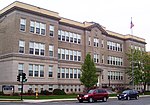Windsor Print Works
Buildings and structures in North Adams, MassachusettsIndustrial buildings and structures on the National Register of Historic Places in MassachusettsNational Register of Historic Places in Berkshire County, Massachusetts

Windsor Print Works is a historic textile mill at 121 Union Street in North Adams, Massachusetts. Founded in 1829, with buildings dating to 1872, it was one of the first textile mills in western Massachusetts, and the first place in the United States to create printed cotton fabric. It was listed on the National Register of Historic Places in 1973. The property now houses a variety of arts-related and light manufacturing businesses.
Excerpt from the Wikipedia article Windsor Print Works (License: CC BY-SA 3.0, Authors, Images).Windsor Print Works
Union Street,
Geographical coordinates (GPS) Address Nearby Places Show on map
Geographical coordinates (GPS)
| Latitude | Longitude |
|---|---|
| N 42.700555555556 ° | E -73.105 ° |
Address
Union Street 121
01247
Massachusetts, United States
Open on Google Maps









